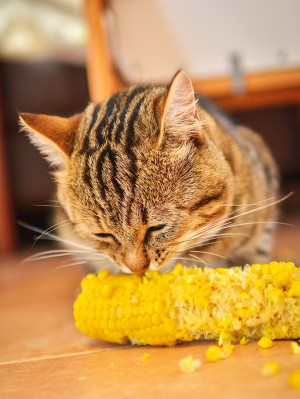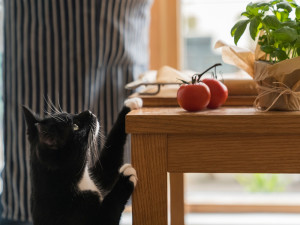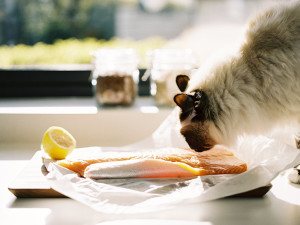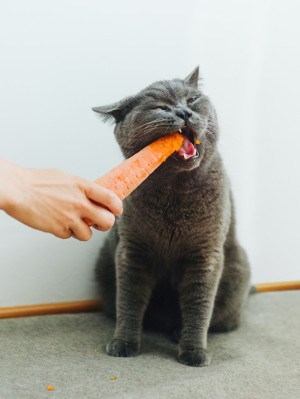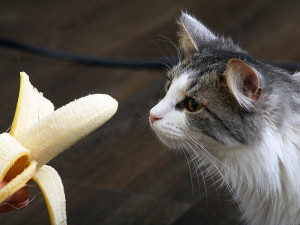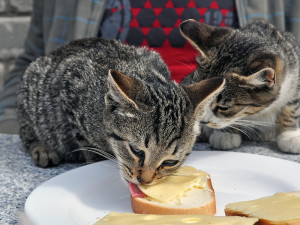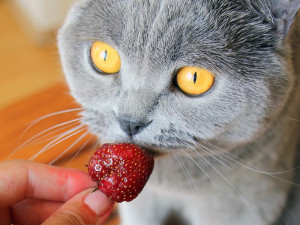Can Cats Eat Chocolate?
No, no, no. Absolutely not. Here’s why.
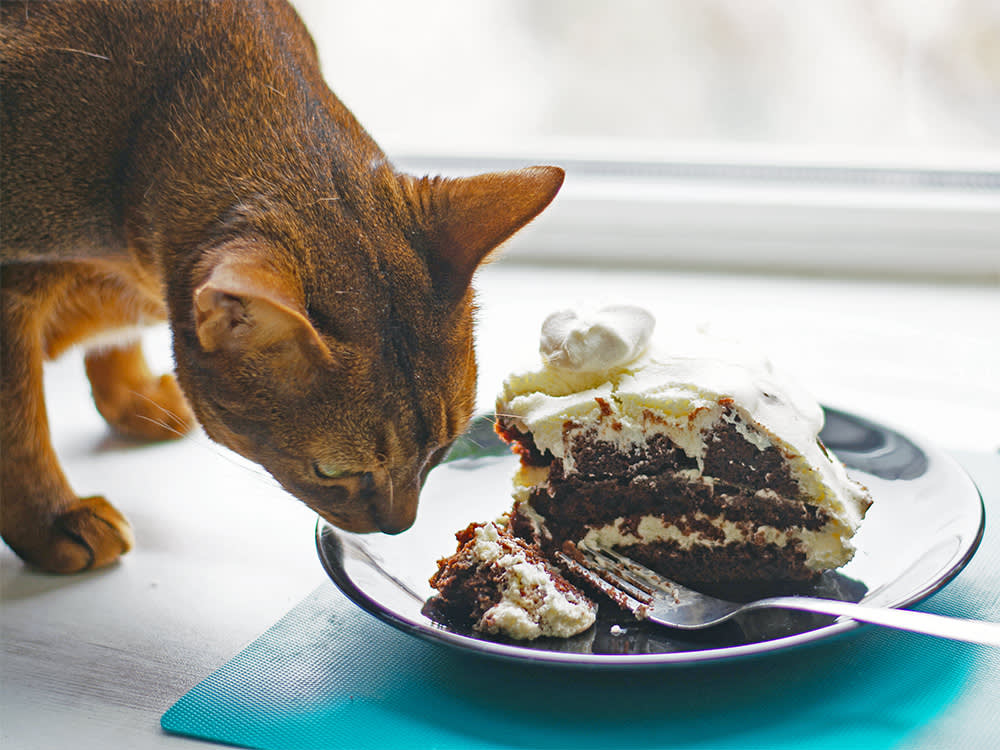
Share Article
Many pet parents recognize chocolate as one of the most common household toxins for dogs, but some don’t realize that it’s a major no-no for cats. In fact, cats are even more sensitive to chocolate than dogs.
If your cat has a sweet tooth or just gets into anything they can for fun, keeping them away from chocolate is crucial. Curious cats may try to eat chocolate bunnies, chocolate eggs, chocolate chips, chocolate bars, or baked goods containing cocoa. If your cat does manage to sneak some chocolate, talking with your veterinarian or a veterinary toxicologist is crucial to determining how to help them.
Nutrition facts: chocolate for cats
Chocolate is a great snack for people because it’s delicious, full of antioxidants (well, at least dark chocolate), and can be part of a healthy dietopens in new tab in small amounts. Unfortunately, cats cannot share in your chocolate indulgences because chocolate contains methylxanthines, which are toxic to cats. The darker the chocolate, the higher the methylxanthine content and the more dangerousopens in new tab it is to your cat.
Theobromine and caffeine are the primary methylxanthines found in chocolate. They have similar effects, and can cause symptoms, such as:

Vomiting
Diarrhea
Hyperactivity
Elevated heart rate
Elevated blood pressure
Heart arrhythmia
Muscle tremors
Seizures
Coma
Death
The severity of the symptoms will depend on the amount and type of chocolate ingested and the size of the cat. Together, caffeine and theobromine create a particularly bad combination for cats, because the caffeine takes effect quickly (within an hour or two) and doesn’t wear off until after the theobromine starts causing problems (within four hours).
The effects of chocolate can last for a long time because cats do not naturally eliminate the toxic substances quickly. Depending on the amount ingested, symptoms can last for days without treatment. Fortunately, recognizing the problem and getting your cat to the vet for treatment can help get rid of the toxins more quickly and keep them safe from the worst effects of chocolate.
Is chocolate always dangerous for cats?
Because cats are small and are sensitive to the toxic components, if they eat any amount of chocolate you should call your veterinarian or a pet poison control center. They can determine if your cat ingested a toxic amount, based on the type of chocolate, amount eaten, and size of your cat.
Cats are usually less interested in sweet foods than dogs, so it’s rare for them to have eaten enough chocolate to result in life-threatening symptoms. Despite their lack of a sweet tooth, cats are curious and will taste almost anything that looks interesting enough. Because of this behavior, chocolate ingestion was the fourth most commonopens in new tab food-related cause for calls about cats to the ASPCA Animal Poison Control Center.
How is chocolate toxicity treated in cats?
If your veterinarian or the toxicologist determines that the chocolate poses a danger to your cat, they will recommend bringing your cat to a clinic. Once there, the vet will perform an examination to check for any signs of toxicosis before proceeding to decontamination. Decontamination starts with administering drugs to attempt to induce vomiting in the guilty cat. This may or may not be successful, because it’s somehow difficult to make a cat vomit when you actually want them to. (Maybe vet’s offices should consider keeping an expensive rug around — they never seem to have an issue throwing up on those!)
Vomiting induction is often followed by anti-nausea medication to help settle the cat’s stomach before the next step of decontamination: activated charcoal. Veterinarians carry a special, concentrated form of activated charcoal liquid that is great at binding to the toxins in chocolate. As you can likely imagine, most cats do not enjoy being fed a mystery liquid, and they show their displeasure by spitting this jet-black substance all over themselves.
If a cat ate enough chocolate that decontamination alone is not expected to prevent problems, your vet will recommend hospitalization for IV fluids and monitoring. Caffeine and theobromine leave the body primarily through the kidneys, so giving them IV fluids helps to speed up excretion. Hospitalization also allows your veterinarian to monitor for any of the more severe signs of toxicosis, like an irregular heart rhythm or high blood pressure and treat those as needed.
Despite the potential dangers of chocolate ingestion, most cats do well with prompt treatment and get back to their previous lives like nothing happened.
The bottom line: Can cats eat human food?
Every cat wants to be a part of whatever their people are eating or cooking. And cat parents get great joy from watching their feline friends chow down on a dropped piece of food or shared bit from their plates. You should only give your cat extra snacks in moderation, with the calories from treats, snacks, and shared food making up no more than 10 percent of your cat’s daily intake. A nutritionally complete food that’s made for cats helps to prevent health problems and nutritional deficiencies.
You should always check to make sure the foods that you’re sharing with your kitty are safe before giving them some. Some surprising human foods can be dangerous for cats to eat, and it’s better to know before you offer something than to have to call the vet in a panic after.
Other foods that are safe for cats
Peanut butter: Cats seem to love the sweet and salty taste of peanut butter, and it’s fun to watch them try to work the sticky substance off the roof of their mouth. A lick here and there is OK, but keep this rich, calorie-packed food limited to an occasional treat.
Ham: Cats are carnivores and enjoy chowing down on a bite of hamopens in new tab as much as you’d imagine. Just avoid ham that has been seasoned with onion or garlic and only give small bits of this salty snack at a time.
Watermelon: Despite their lack of a sweet tooth, many cats seem to be drawn to the smell and taste of melons. Watermelon is no exception, and your cat may enjoy sharing a mouthful of this water-rich food. Watermelon is high in sugar though, so it’ll have to be limited to a small summertime share.
Other foods that are dangerous for cats
Garlic: Garlic is part of the Allium family, which contains substances that cause damage to red blood cells. This can result in a severe anemia, weakness, respiratory difficulty, and death. All forms of garlic (fresh, cooked, dried, powder) are toxic.
Onion: Similar to garlic, onions are a member of the Allium family and have the same toxic effects. Be cautious about sharing soups and broths with your kitty because they often contain onion in significant amounts.
Milk: Despite the classic image of kittens lapping at a bowl of warm milk, cats should not be given milk. Much like lactose-intolerant people, kitties lack the enzyme lactase, which breaks down the lactose in milk. Because of this, drinking milk can cause a cat gastrointestinal upset, gas, cramping, and diarrhea.
FAQs (People also ask):
Is it OK to give cats chocolate?
Chocolate is dangerous for cats to eat and should not be offered to them or kept in areas where they can access it. Chocolate can cause life-threatening symptoms if a cat eats enough of it.
How much chocolate can a cat eat?
No amount of chocolate should be considered safe for a cat. While small amounts may only cause stomach upset, it doesn’t take much chocolate to cause significant problems for a cat.
References:

Dr. Bartley Harrison, DVM
Dr. Bartley Harrison is a veterinarian with more than 19 years of experience. He has treated a variety of species in emergency and speciality practices for both large and small animals. His primary interests as a vet are emergency medicine and critical care.
Related articles
![A kitten sniffing a ripe half of an avocado in a bowl]()
Can Cats Eat Avocados?
Just don’t get out the guacamole bowl.
![Cat eating from a plate of raspberries and blueberries]()
Can Cats Eat Blueberries?
Go ahead and serve up the superfood — with a couple caveats.
![A cat staring at a peeled banana]()
Can Cats Eat Bananas?
Gwen Stefani taught us how to spell it, but can we feed this fruit to our cats?
![Two grey cats eating swiss cheese off of slices of bread while sitting on a table]()
You Should Not Invite Your Cat to Your Fancy Cheese Party
Save the charcuterie for the humans.
![Woman with tattoos eating noodles on the couch with her cat]()
Can Cats Eat Garlic?
It’s a human cooking staple, but your cat shouldn’t indulge.
![Grey cat eats a strawberry]()
Can Cats Eat Strawberries
Yes, strawberries are a nutritious treat for dogs.

